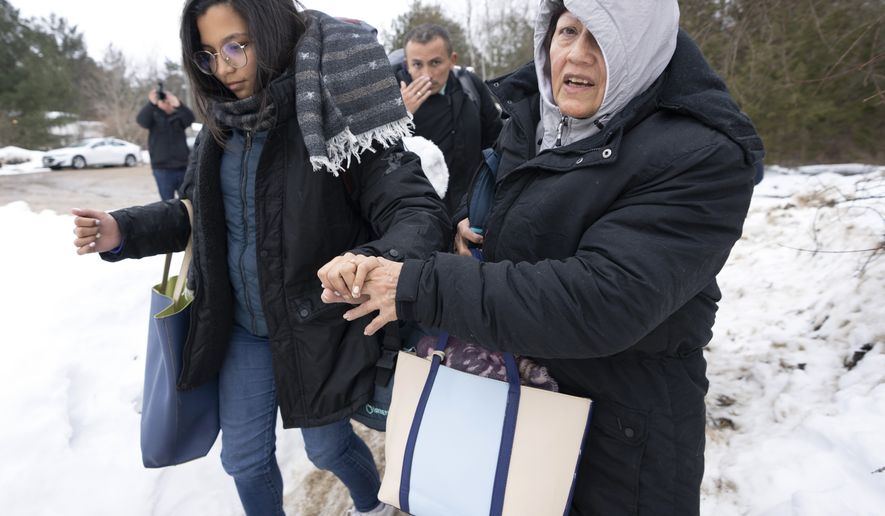Temperatures may have dipped to below zero along the U.S.-Canada border last month, but the pace of illegal immigration was overheated as people poured across the less-protected northern boundary.
The Border Patrol’s Swanton sector, which covers New Hampshire, Vermont and the northern tip of New York and is generally the most active region in the north, said Monday that it’s running at “historic” levels of detected illegal crossings.
Agents there nabbed more people last month than in the previous 12 Januaries combined.
“As we progress deeper into winter and continue to address the ongoing pace of illicit cross-border traffic, the level of concern for the lives and welfare of our Border Patrol Agents and those we are encountering — particularly vulnerable populations — continues to climb,” said Robert N. Garcia, chief patrol agent in the Swanton sector.
Among those his agents have nabbed are families with infants.
Days earlier, Customs and Border Protection released data showing that while the situation at the southern border has cooled from catastrophe to chaos, the northern boundary remains at record levels.
Agents in Swanton nabbed 367 unauthorized migrants in January and topped 1,500 dating to Oct. 1, which marked the start of fiscal 2023. That’s already more than all of 2022 for the sector.
Across the entire northern border, agents have encountered more than 2,200 illegal immigrants so far this fiscal year, about equal to all of last year.
More broadly, CBP recorded more than 13,000 unauthorized migrant encounters when those who showed up at ports of entry without permission are included.
Canadians make up the largest number, but Indian nationals are close behind with nearly 2,500 last month.
There were also nearly 700 Chinese, nearly 700 Mexicans, more than 200 Filipinos, more than 150 Brazilians and about 250 Colombians.
For some, it has become easier to sneak into the U.S. from the north than from the south.
“You’re seeing some Mexican single adults now going to Canada and coming across the Swanton sector because it’s easy,” said Mark Morgan, who led CBP in the latter part of the Trump administration. “Our southern border, as bad as our southern border is, it’s better than our northern border.”
That was the situation in one case in October, when Border Patrol agents grew suspicious of a vehicle that approached the border with just a few visible occupants and then crossed back from the border with more people inside.
Four migrants were being smuggled: two from Mexico, one from Guatemala and one from Uzbekistan.
They paid up to $5,000 to be smuggled, less than half the going rate to cross the U.S.-Mexico border.
Authorities charged two young adults with smuggling. Both were illegal immigrants themselves — one from Guatemala and one from Honduras — who had come as unaccompanied alien children during previous border surges.
One of them came in 2016 and was still awaiting her immigration court hearing. The other arrived in 2019 and said his immigration court hearing isn’t scheduled until July 2024.
Illegal immigrants smuggling other illegal immigrants is a frequent refrain in the cases filed in the Swanton sector.
That was true for another October case in which agents nabbed a Colombian man carrying two fellow migrants from Colombia. The driver sneaked across the southern border in November 2021 and was caught and released under Homeland Security Secretary Alejandro Mayorkas’ parole powers, according to authorities.
The driver obtained a fraudulent green card that he was using to hold down a job, according to court documents.
Swanton sector is the most active of the Border Patrol’s northern regions, and the Blaine sector, in western Washington state, is the second most active. They combine for more than three-quarters of illegal activity, and both have reported a ninefold increase this year from this time in 2022.
To be sure, the numbers are tiny compared with the situation in the south.
CBP reported encountering 13,000 to 16,000 unauthorized migrants each month since the summer along the boundary with Canada. In the south, those numbers exceeded 200,000 every month except for the just-concluded January.
Biden administration officials took a victory lap after the January numbers were released, saying they had finally figured out some solutions. That includes a new program to allow in up to 30,000 migrants a month from Venezuela, Haiti, Cuba and Nicaragua through a special parole program while promising to get tough on those who try to come outside the program.
Border Patrol apprehensions at the southern border from those four countries plummeted from more than 84,000 in December to fewer than 12,000 in January.
Overall, Border Patrol apprehensions dropped from nearly 222,000 on the southern border in December to fewer than 129,000 last month.
“These numbers and these achievements are no coincidence,” one administration official said in briefing reporters about the numbers.
Mr. Morgan, though, said the Department of Homeland Security has only converted an illegal flow into a quasi-legal category by using its parole strategy.
• Stephen Dinan can be reached at sdinan@washingtontimes.com.




Please read our comment policy before commenting.